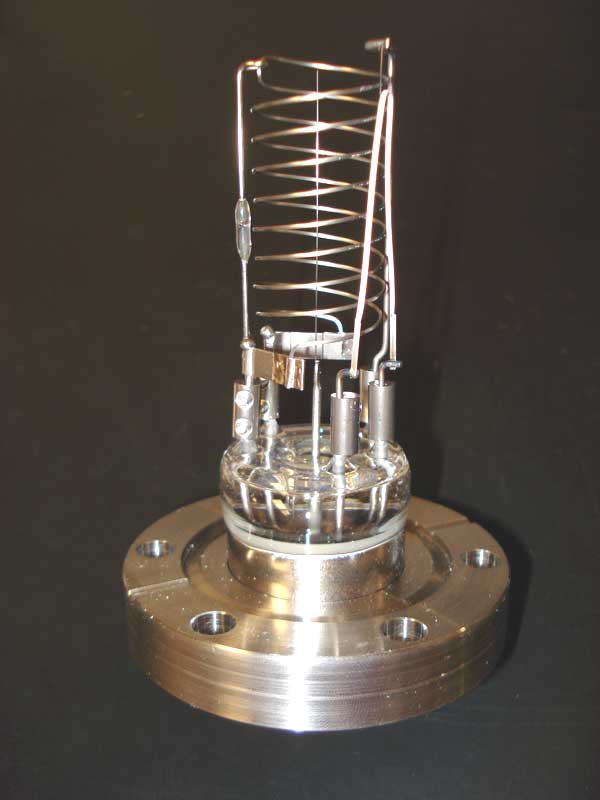- Hot filament ionization gauge
Infobox Laboratory equipment
name = Hot filament ionization gauge
caption = Bayard-Alpert hot thoriated iridium filament ionization gauge on 2.75 in conflat flange
acronym =
other_names = Hot cathode gauge Bayard-Alpert gauge
uses = Pressure measurement
inventor =
manufacturer =
model =
related = The hot filamentionization gauge , sometimes called a hot filament gauge or hot cathode gauge, is the most widely used vacuum (negative pressure) measuring device for the region from 10-3 to 10-10 torrs. It is atriode , where as the filament is thecathode ."Note: Principles are mostly the same for hot cathode ion sources in
particle accelerator s to create electrons"Function
A regulated electron current (typically 10 mA) is emitted from a heated filament. The electrons are attracted to the
helical grid by a dc potential of about +150 volts. In their passage from the filament to thegrid the electrons collide with gas molecules in the gauge envelope causing a fraction of them to be ionized. The gas ions formed by the electron collisions are attracted to the central ion collector wire by the negative voltage on the collector (typically a minus 30 volts). Ion currents are on the order of 1 mA/Pa. This current is amplified and displayed by a high gain differential amplifier/electrometer .This
ion current will differ for different gases at the same pressure, that is, a hot filament ionization gauge is composition-dependent. Over a wide range ofmolecular density , however the ion current from a gas constant composition will be directly proportional to the molecular density of the gas in the gauge.Copied from the ionization gauge article (Somehow there is too much duplication in the structure):
A hot cathode ionization gauge is mainly composed of three electrodes all acting as a
triode , where thecathode is the filament. The three electrodes are a collector or plate, afilament , and agrid . The collector current is measured inpico amps by anelectrometer . The filament voltage to ground is usually at a potential of 30 volts while the grid voltage at 180–210 volts DC, unless there is an optionalelectron bombardment feature, by heating the grid which may have a high potential of approximately 565 volts.The most common ion gauge is the hot cathode Bayard-Alpert gauge, with a small collector inside the grid. A glass envelope with an opening to the vacuum can surround the electrodes, but usually the Nude Gauge is inserted in the vacuum chamber directly, the pins being fed through a ceramic plate in the wall of the chamber. Hot cathode gauges can be damaged or lose their calibration if they are exposed to atmospheric pressure or even low vacuum while hot.Electrons emitted from the filament move several times in back and forth movements around the grid before finally entering the grid. During these movements, some electrons collide with a gaseous molecule to form a pair of an ion and an electron (
Electron ionization ). The number of theseions is proportional to the gaseous molecule density multiplied by the electron current emitted from the filament, and these ions pour into the collector to form an ion current. Since the gaseous molecule density is proportional to the pressure, the pressure is estimated by measuring the ion current.The low pressure sensitivity of hot cathode gauges is limited by the photoelectric effect. Electrons hitting the grid produce x-rays that produce photoelectric noise in the ion collector. This limits the range of older hot cathode gauges to 10-8 Torr and the Bayard-Alpert to about 10-10 Torr. Additional wires at cathode potential in the line of sight between the ion collector and the grid prevent this effect. In the extraction type the ions are not attracted by a wire, but by an open cone. As the ions cannot decide which part of the cone to hit, they pass through the hole and form an ion beam. This ion beam can be passed on to a
*Faraday cup
*Microchannel plate detector with Faraday cup
*Quadrupole mass analyzer with Faraday cup
*Microchannel plate detector with Faraday cup
*Quadrupole mass analyzer with Microchannel plate detector Faraday cup
* ion lens and accelartion voltage and directed at a target to form a sputter gun. In this case a valve lets gas into the grid-cage.Types of hot filament ionization gauges
* Bayard Alpert (uses sealed tube; see Review of Scientific Instruments, 1950, Vol. 21, pg.571 for original desccription)
* Nude gauge (uses the vacuum chamber to make a complete seal).See also
*
Ionization gauge
*Vacuum
*Electron ionization External links
* [http://www.duniway.com/images/pdf/pg/hot-filament-ion-gauge-tube.pdf Hot filament ionization gauge tubes]
* [http://www.patentgenius.com/patent/4792763.html U.S. Patent 4792763] - Hot cathode ionization pressure gauge
* [http://www.patentgenius.com/patent/5373240.html U.S. Patent 5373240] - Hot-cathode ionization pressure gauge including a sequence of electrodes arranged at a distance from one another in sequence along an axis
Wikimedia Foundation. 2010.
